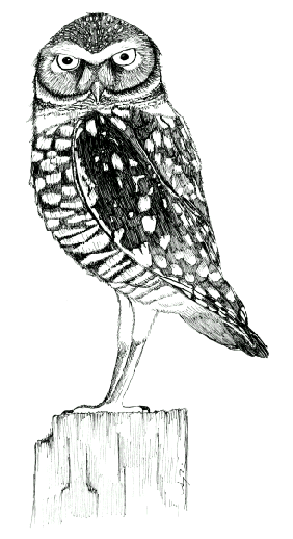|

(drawing
by Amy Mui)
|
|
Description:
The Burrowing Owl is a small owl, similar in size to an American
Robin. It has disproportionately long legs, making it look
larger than it really is. The back and wings are brown with
small light spots; the underparts are whitish with broad brown
barring. The facial disk is not as prominent as on some other
owls, but the white eyebrows on the forehead are very
noticeable. The Burrowing Owl uses a variety of hunting
techniques, sometimes pouncing on prey from a perch such as a
fencepost, occasionally hovering above prey before dropping on
it, and often simply walking or running along the ground
catching insects. It is active both during the day and at night.
Requirements: The Burrowing Owl breeds in dry, open areas
of western North America, including parts of southern Manitoba,
Saskatchewan, Alberta, and British Columbia.
As its name suggests, the Burrowing Owl lives in holes in the
ground. Though it can modify existing tunnels with its beak and
feet, the Burrowing Owl depends on other species such as prairie
dogs, ground squirrels, and badgers to dig the original hole.
The burrows favoured by owls are usually in or near grassy areas
with low vegetation for easy hunting, and are 4 to 10 metres
long, with a sharp bend in the tunnel to ensure that the nesting
chamber at the end is in complete darkness. The female lays an
average of seven eggs, and stays inside for four weeks straight
to incubate them, during which time the male brings her food.
The diet of the Burrowing Owl is dominated by insects,
especially larger varieties such as grasshoppers, scorpions,
beetles, dragonflies, and moths. At night it switches to hunting
a variety of small mammals. Young Burrowing Owls fledge around
44 days, but remain with their parents for a while after that. |
Conservation:
The Burrowing Owl was classified as an endangered species in Canada in
1995, and is also considered endangered or threatened in most US states
where it occurs. Recently the Canadian population was estimated to be
only 1000 breeding pairs in Alberta and Saskatchewan, and declining by
16% per year. The main problem for the Burrowing Owl is the loss of
breeding habitat. Grasslands have been reduced in size, and many farmers
have tried to eliminate prairie dogs because they damage crops. But
without the prairie dogs digging holes, the Burrowing Owl has nowhere to
nest. Even Burrowing Owls which find a home face serious problems. They
often hunt near roads, and many are killed by cars. Domestic cats and
dogs also kill many owls, and they also suffer some natural predation
from mammals and larger raptors such as the Ferruginous Hawk.
The use of chemical pesticides on insects and rodents has caused the
death of many Burrowing Owls too. This is particularly unfortunate
because the Burrowing Owl can be very beneficial to farmers by eating
these animals. In Saskatchewan, Operation Burrowing Owl has encouraged
more than 450 landowners to protect 7600 square kilometres of Burrowing
Owl habitat, and Operation Grassland Community in Alberta has protected
another 230 square kilometres. With continued support from landowners
and some additional efforts to reduce other causes of mortality, the
Burrowing Owl will hopefully be able to continue to live in Canada. |
